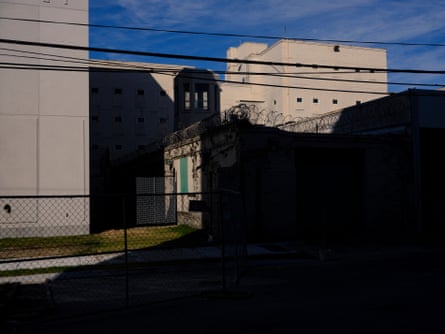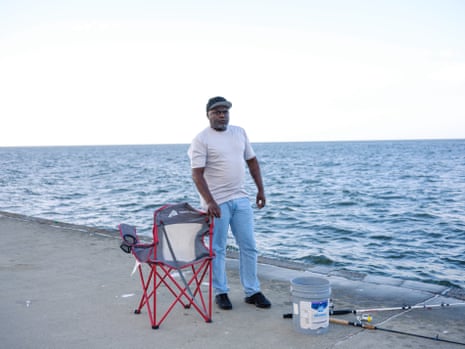On his 16th birthday, Charles “Chuck” Daniel was put behind bars.
Then, six months later, in the summer of 1996, he would find himself transferred to Louisiana’s Angola prison – referred to by some as the “Alcatraz of the south” – to serve out a 149-year sentence for attempted murder and armed robbery that in effect amounted to life imprisonment.
Daniel, one of Angola’s youngest prisoners at that time, was technically separated from adult cells. But this didn’t stop him from enduring punishment from older inmates.
His slight frame – 4ft 11in and 90lbs – made him a target. Adult inmates would throw their own feces at Daniel, leaving him with two options: to sit in the filth until the next day’s shower or wash himself with the toilet water in his cell.
Daniel had one hour of restricted freedom from his cell daily: 45 minutes to roam the hallway and 15 minutes to shower.
“It’s inhumane for a youngster to be in that type of position,” Daniel said.
Though Daniel, now 44, is not involved in the case, his experience as told to the Guardian illustrated the stakes at the center of a federal class-action lawsuit which – for now – has halted Louisiana’s practice of housing underage detainees at its harshest penitentiary.
The case started after six minors escaped from a juvenile detention center in Bridge City, Louisiana, outside New Orleans, last summer.

They were able to get out because of the detention center’s lack of adequate staff and dilapidated building conditions. Louisiana’s outgoing Democratic governor, John Bel Edwards, announced an ongoing internal investigation into the facility’s security failures – but in the meantime, about two dozen youths at the lockup deemed to be the most violent were moved to a vacant, former death row at Angola.
Like Daniel was, the Bridge City youth were separated from adult inmates at all times, as demanded by federal law.
July court filings – backed by the American Civil Liberties Union’s National Prison Project and other civil rights attorneys – revealed that the youth housed in Angola suffered extended periods of solitary confinement, without access to clean water, adequate food and air conditioning.
In the federal class-action lawsuit, the 17-year-old plaintiff Charles C stated: “My cell is incredibly small and I have no room to move. I can’t drink the water out of the faucet because it has a color, tastes bad, and would make me sick. I worry about my mental health because I’m forced to be in these cells.”
In the midst of a record-breaking heat this summer, the former death row did not provide air conditioning, Alex A – another 17-year-old plaintiff – said.




Educational and mental health resources, like a library and a full staff of teachers, were nonexistent. And Angola’s vast distance from other more populous areas in the state made it nearly impossible for juveniles to schedule family visits.
After a seven-day hearing, US district judge Shelly Dick ordered the removal of teens from Angola’s facility due to the “intolerable” conditions. Daniel said that the conditions on the former death row and the youth’s poor treatment sounded identical to what he endured nearly three decades earlier.
So did Paul Stone, now 51, who was transferred to Angola shortly after his 17th birthday for second-degree murder. Stone said a board at the prison determined whether he would be placed in cells with other juveniles or with the general adult population. The board not only took his criminal charges into account – but also his height and physical looks – before placing him with juveniles.




Stone, like Daniel, said that the guards did not make physical contact with him when he was a minor. But they would allow the adult inmates to punish minors. He said that if a juvenile argued with a guard, the guard would open their cell for older inmates to enter.
“You ever heard how Angola was the bloodiest prison in the nation at one time?” Stone said. “I’m going to say it like that. It was the bloodiest prison in the nation.”
At one point, suicides from hangings and stabbings were so common among inmates at Angola that the prison declared a state of emergency and called for hundreds of guards from other prisons to hunt down weapons within the cells, Stone said. Stone, who was 40 when he was released from Angola, said it was unlike anything he had ever seen in his life.
Both Daniel and Stone have been paroled. A spokesperson for the prison said he could not comment on their recollections without more specifics.
The administration in charge of the juvenile justice system became its own independent agency from Louisiana’s department of corrections in 2004. Mary Livers – the former deputy secretary of the juvenile justice office – said that she was concerned that the agency might lose its independence and get folded back into the adult system, despite previous steps toward reform.




“Juveniles are not little adults,” Livers said. “The juvenile justice system is supposed to be different from the adult system.”
Livers said that rather than confinement, facilities for juveniles should be a therapeutic, small-group and modernized environment that focuses on changing behavior. Placing juveniles at an Angola facility that was originally made for adults sends the wrong message that they are “the worst of the worst”, Livers said.
The office of juvenile justice announced in September that juveniles at Angola were transferred to a new facility in Jackson parish. But the office described the arrangement as temporary.
The office said it intended to appeal Judge Dick’s ruling, arguing that the judge’s finding of unconstitutional facility conditions was incorrect.
This post was originally published on this site be sure to check out more of their content.








